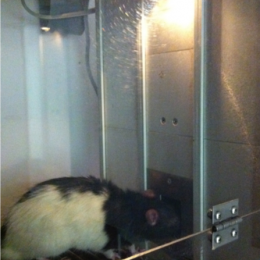Our main research interests are in understanding individual differences in learned behavior and its implications for attenuating reward and drug related memories. Some of our work is done in close collaboration with Drs. Marie Monfils in our department and Rueben Gonzales in the college of Pharmacy.
1. INDIVIDUAL DIFFERENCES IN LEARNED BEHAVIOR
Our research team recently demonstrated that rats display a simple learned behavior with significant individual variations and that these differences might reflect different ways they process and store learned information. In our lab, rats are typically trained to learn that a light presentation in a conditioning box predicts delivery of food reward. This simple learning process is very important in understanding how environmental cues can gain control over one’s behavior and even contribute to pathological conditions such as drug addiction. Environmental cues become linked with reinforcing effects of drug and later induce a vulnerable state of drug craving and can elicit drug-seeking behaviors. It has been proven very difficult to “break” this established link and attenuate behaviors triggered by the environmental cues.
In our typical paradigm, after repeated pairings of the light with food, rats acquire various conditioned responses. One common conditioned response displayed by all rats is to approach and monitor the place where the food reward is delivered (see Fig 1). This is an adaptive learned behavior that allows immediate access to the food when it is delivered. Curiously, however, some rats display another conditioned response directed toward the light itself by orienting toward or approaching the light (see Fig 2). This behavior is not needed to obtain the reward and even can be costly because access to the food reward can be delayed. This seemingly maladaptive behavior towards a cue has been observed in a number of different species in various settings. Furthermore, there appears to be substantial individual differences in the expression of this cue-directed behavior where some subjects show high levels of the behavior and others do not. Because cue-directed behaviors are thought to reflect the acquired salience of the cue, the individual differences suggest that different animals process the cue information differently over the course of learning. This further suggests some fundamental differences in the brain function of these rats. However, it is not clear how the presumably different nature of learning influences the way this learned information (memory) is stored, retrieved and processed.

Fig 1. Conditioned foodcup approach

Fig 2. Conditioned orienting
2. ORIENTING PHENOTYPE
Even though cue-directed behaviors such as orienting to the light are not needed for the rat to obtain the food reward, they can be persistent and even resistant to attempts to eliminate them. As a consequence, cue-directed behaviors have been proposed to be a form of impulsivity or reduced inhibitory control. In fact, the rats that display a strong orienting response to the light also exhibit more impulsive and risky choices in other tasks. Interestingly, these rats also show distractibility during an attentional task. We believe the orienting phenotype is well suited to serve as an animal model for understanding behavioral symptoms and treatment for disorders associated with attentional and impulsive issues such as ADHD.
Poor impulse control and risky decision-making are neurocognitive traits associated with populations susceptible to drug abuse. We are interested in testing whether orienting phenotype can predict addiction vulnerability. Our recent work suggests that rats with enhanced orienting behavior do show greater preference to amphetamine. We are currently focused on knowing whether orienting phenotype can predict certain aspects of drug addiction, treatment, and relapse process.
3. REDUCING ALCOHOL-SEEKING BEHAVIOR
Excessive alcohol use is driven by various factors that are biological, psychological, and social in nature. The degree of how these factors contribute to problematic drinking and then relapse after recovery vary widely at the individual level. One common factor presented to all the users of alcohol is the set of cues closely linked to alcohol consumption. Environmental cues that reliably precede alcohol availability and subsequent consumption can gain the ability to elicit conditioned responses such as alcohol-seeking behavior and promote problematic drinking. We are interested in conditioned responses to alcohol because of the potential to manipulate these responses to reduce relapse. We are currently examining the conditions and neural substrates that influence extinction and relapse of alcohol seeking in a rat model of alcohol dependence.

